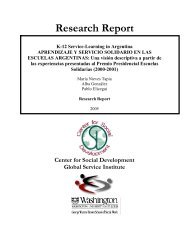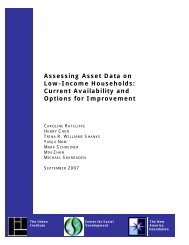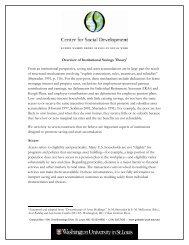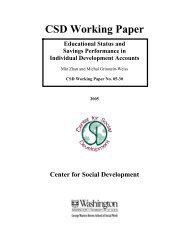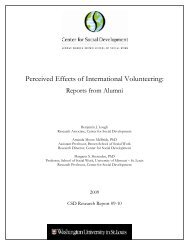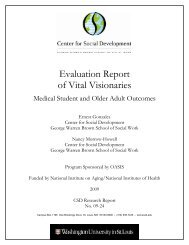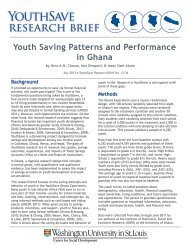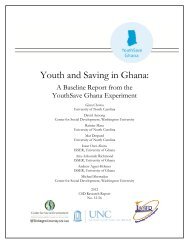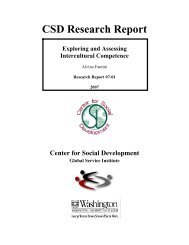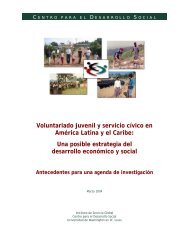Rediscovering social investment in developmental welfare state ...
Rediscovering social investment in developmental welfare state ...
Rediscovering social investment in developmental welfare state ...
Create successful ePaper yourself
Turn your PDF publications into a flip-book with our unique Google optimized e-Paper software.
R E D I S C O V E R I N G S O C I A L I N V E S T M E N T I N D E V E L O P M E N T A L W E L F A R E S T A T E P O L I C I E S :<br />
B A C K T O T H E F U T U R E<br />
<strong>in</strong>terrelation that is pert<strong>in</strong>ent than the actuality that many <strong>social</strong> conditions may turn out to have<br />
economic implications, whether fully recognized or not.<br />
Among the various schools of neoclassical economics, the Chicago School has offered the most<br />
strident criticism of redistribution and the <strong>welfare</strong> <strong>state</strong>. The microeconomic work of Stigler (1961,<br />
1966, 1975) and macroeconomic work of Friedman (1953, 1956, 1960, 1968)—<strong>in</strong>spir<strong>in</strong>g public<br />
choice theory (Buchanan & Tullock, 1962; Niskanen, 1971) and m<strong>in</strong>imal government arguments<br />
(Canto et al., 1983)—form a generalized view of the <strong>welfare</strong> <strong>state</strong>. The <strong>welfare</strong> <strong>state</strong> is generally<br />
considered to have ―distort<strong>in</strong>g effects on the automatic clear<strong>in</strong>g mechanism by affect<strong>in</strong>g wages, labor<br />
supply, or labor costs‖ (Esp<strong>in</strong>g-Andersen, 1990, p. 144). In other words, it <strong>in</strong>terferes with the<br />
clearance of surpluses and shortages by restrict<strong>in</strong>g the ability of prices to change and obstruct<strong>in</strong>g the<br />
ability of the economy to achieve equilibrium. If markets were generally efficient to beg<strong>in</strong> with,<br />
distort<strong>in</strong>g them is likely to produce <strong>in</strong>efficiencies. While research has dealt with issues such as<br />
sav<strong>in</strong>gs rates, crowd<strong>in</strong>g out of capital <strong><strong>in</strong>vestment</strong>, and the like, the literature has tended to focus on<br />
the negative-<strong>in</strong>centive effects of <strong>social</strong> benefits on labor supply and mobility at the micro level, along<br />
with attempts to argue their effects at the macro level (Danziger et al., 1981; L<strong>in</strong>dbeck, 1981). In this<br />
view, transfers are least likely to do harm when they remediate severe poverty.<br />
In contrast, <strong>in</strong> the <strong>developmental</strong>ist view, markets are likely to leave some <strong>in</strong>dividuals with limited<br />
resources. A <strong>social</strong> policy that redistributes <strong>in</strong>come may enable these <strong>in</strong>dividuals to ga<strong>in</strong> capabilities<br />
that will then be productive <strong>in</strong> the long run. Moreover, redistribution may lead to low-<strong>in</strong>come<br />
<strong>in</strong>dividuals hav<strong>in</strong>g more access to goods, services, and opportunities, and this may also have<br />
productive consequences <strong>in</strong> the future. From a <strong>developmental</strong>ist perspective, long-term <strong><strong>in</strong>vestment</strong>s<br />
are important and can lead to growth. Moreover, transfers are most likely to have positive effects<br />
when they prevent poverty.<br />
Beyond a generalized critique of the <strong>welfare</strong> <strong>state</strong>, neoclassical theory does address <strong>in</strong> some detail<br />
likely effects of various types of <strong>social</strong> policies. The neoclassical view prefers cash benefits to <strong>in</strong>-k<strong>in</strong>d<br />
benefits, as I discuss below. It has a more nuanced perspective on means-tested versus universal<br />
benefits, see<strong>in</strong>g disadvantages of each. Neoclassical theory does not speak <strong>in</strong> as much detail to family<br />
policy and ALMP beyond suggest<strong>in</strong>g that the earn<strong>in</strong>gs-related, contributory approach should be<br />
expanded, benefit duration and replacement rates kept low, and subsidies provided should take the<br />
form of cash. I briefly elaborate on each of these <strong>in</strong> turn. 52<br />
From an economic efficiency perspective, cash transfers are generally deemed to be superior to <strong>in</strong>k<strong>in</strong>d<br />
transfers because they do not directly <strong>in</strong>fluence market prices. Economic efficiency is enhanced<br />
to the extent that the marg<strong>in</strong>al benefit of goods and services sold <strong>in</strong> an economy is equivalent to<br />
their marg<strong>in</strong>al <strong>social</strong> cost. Transfer programs that lower prices of target goods for the poor will<br />
cause <strong>in</strong>dividuals to consume more of these goods than they would <strong>in</strong> the absence of the program,<br />
which will result <strong>in</strong> resources that could be used more efficiently <strong>in</strong> produc<strong>in</strong>g other goods and<br />
<strong>welfare</strong>. Mishan (1962) notes that it makes design<strong>in</strong>g second-best policies for all situations impractical. However, one<br />
could argue that to the extent that the latter is a goal, broader more encompass<strong>in</strong>g and uniform <strong>social</strong> policies are less<br />
likely to <strong>in</strong>troduce undesirable and unexpected distortions. In other words, the adverse effects (and foregone benefits) of<br />
piecemeal policymak<strong>in</strong>g undertaken on a grand scale are reduced with preventive <strong>in</strong>stitutional policies (Esp<strong>in</strong>g-Andersen<br />
& Korpi, 1987) that anticipate failures and distortions (i.e., universal and <strong>in</strong>-k<strong>in</strong>d benefits may be best suited to<br />
overcom<strong>in</strong>g the two ma<strong>in</strong> second-best critiques).<br />
52 The follow<strong>in</strong>g discussion provides a cursory overview of much more complex arguments regard<strong>in</strong>g the possible<br />
antipoverty effectiveness and efficiency implications of various types of transfers. A thorough and authoritative<br />
exploration of these issues is available <strong>in</strong> Garf<strong>in</strong>kel (1982).<br />
C E N T E R F O R S O C I A L D E V E L O P M E N T<br />
W A S H I N G T O N U N I V E R S I T Y I N S T . L O U I S<br />
36



